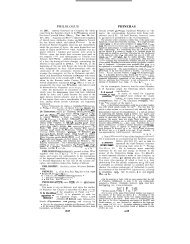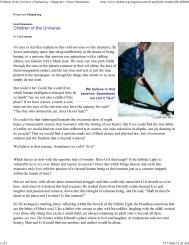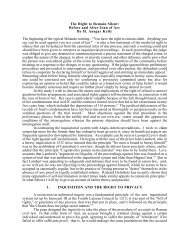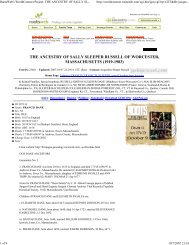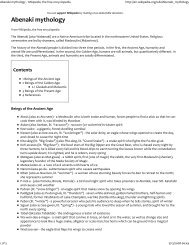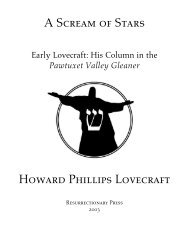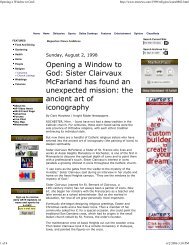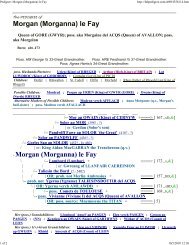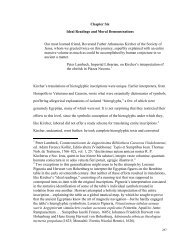sefi;g:v. - A Kabbalist walks into a bar, and the
sefi;g:v. - A Kabbalist walks into a bar, and the
sefi;g:v. - A Kabbalist walks into a bar, and the
You also want an ePaper? Increase the reach of your titles
YUMPU automatically turns print PDFs into web optimized ePapers that Google loves.
SENNAGHERIB SENNAGHERIB<br />
waxes eloquent over <strong>the</strong> immense array that faced <strong>the</strong><br />
Assyrian army. They were ’like a great swarm’ of<br />
locusts. ‘ The dust of <strong>the</strong>ir feet was like a heavy storm<br />
cloud which spreads over <strong>the</strong> wide heaven about to<br />
break in downpour.’ The account of <strong>the</strong> battle given<br />
by Sennacherib is a masterpiece of description, but too<br />
long to quote. He claims to have defeated his enemies<br />
with tremendous slaughter <strong>and</strong> terrible butchery. The<br />
Babylonian Chronicle, however, claims <strong>the</strong> victory for<br />
Elam. At any rate Sennacherib returned to Nineveh for<br />
a time. It is not clear in which year <strong>the</strong> battle occurred ;<br />
perhaps it was in 691 B.C. In 689 B.C. (Nisan <strong>the</strong> rgth),<br />
Urnman-minilnu had a stroke of paralysis <strong>and</strong> lost his<br />
speech. Sennacherib seized <strong>the</strong> opportunity to attack<br />
Babylon, which was without Elamite assistance. On<br />
<strong>the</strong> first of Kislimu <strong>the</strong> city was taken, MuSezib-<br />
Marduk was carried away captive to Xssyria, hfarduk<br />
himself was taken to ASur. Babylon was sacked,<br />
its walls razed to <strong>the</strong> ground, <strong>the</strong> greater portion<br />
of <strong>the</strong> houses burnt, its inhabitants driven out, or deported,<br />
<strong>and</strong> <strong>the</strong> waters of <strong>the</strong> Euphrates turned over<br />
<strong>the</strong> site. For eight years <strong>the</strong> Babylonian Chronicle <strong>and</strong><br />
Ptolemy’s Canon write <strong>the</strong> city down as ‘ kingless.‘<br />
Some time after this Sennacherib made an expedition<br />
to Arabia. This we learn from a notice by Esarhaddon.<br />
Adumd was captured <strong>and</strong> <strong>the</strong> gods carried off to Assyria.<br />
Winckler sees in this an excuse for postulating a second<br />
expedition of Sennacherib to <strong>the</strong> W., at any rate to<br />
Arabia <strong>and</strong> Egypt. Several fragmentary inscriptions<br />
have been published which are consistent with <strong>the</strong><br />
supposition that <strong>the</strong>re is a cylinder at least partly preserved,<br />
which narrated events occurring after 688 B.C.<br />
There is no means, however, of dating <strong>the</strong> events until<br />
<strong>the</strong> remaining historical inscriptions are published. The<br />
reference to Xzekah, noted by Homniel, may belong to<br />
<strong>the</strong> reign of Sargon. No convincing evidence from<br />
cuneiform sources is available to support a second<br />
expedition of Sennacherib to <strong>the</strong> W. All sources are<br />
silent as to <strong>the</strong> last eight years of his reign.<br />
Sennacherib was <strong>the</strong> maker of NINEVEH (4.v.).<br />
His inscriptions are very full on <strong>the</strong> subject of his<br />
4. O<strong>the</strong>r great buildings <strong>the</strong>re.<br />
Some think that it<br />
was with a view to make Nineveh supreme<br />
details. that he humbled Babylon so completely;<br />
but <strong>the</strong> trouble it had given him <strong>and</strong> <strong>the</strong> memory of<br />
his son amply account for his policy.<br />
Besides ASur-&din-Sum, king of Babylon, 699-693<br />
B.c., doubtless Sennacherib’s eldest son, we know of a<br />
son Ardi-Bilit, crown prince in Nineveh, in 694 8. c. ;<br />
ASur-Sum-ugabS, a son for whom Senoacherib built a<br />
palace at Scherif Khan ; Nergal-Sum-(usur?), named in<br />
693 B. c. ; Sar-efir-ASur, whom Wiuckler wow make <strong>the</strong><br />
Sharezer of z K. 1937 ; <strong>and</strong> ESARHADDON (g.~.), who<br />
succeeded him. The mo<strong>the</strong>r of Esarhaddon seems to<br />
have borne <strong>the</strong> names ZakQtu <strong>and</strong> Nakla. For an<br />
account of a jewel belonging to this queen, see Scheil,<br />
Rec. des Trav., <strong>and</strong> see <strong>the</strong> article ESARHADDON for<br />
her rBle as regent in Assyria. Her sister was called<br />
Abirami. Sennacherib also left a daughter called<br />
Matt&.<br />
Sennacherib was murdered by his son, according to<br />
<strong>the</strong> Babylonian Chronicle, <strong>and</strong> <strong>the</strong> Canon Lists, on <strong>the</strong><br />
20th of ’TebCtu, 682 B.C. On <strong>the</strong> biblical account of<br />
<strong>the</strong> murder, see ADRAMMELECH, SHAREZER, <strong>and</strong><br />
NISROCH. C. H. W. J.<br />
With regard to <strong>the</strong> history of <strong>the</strong> relations between<br />
Sennacherib <strong>and</strong> <strong>the</strong> kingdom of Judah, th-re is much<br />
~. Relations difference of opinion. The chief pods<br />
with Judah. in dispute are (I) whe<strong>the</strong>r <strong>the</strong> Hebrew<br />
narratives, except where <strong>the</strong>y coincide<br />
with <strong>the</strong> cuneiform record, can be used at all for<br />
historical purposes, <strong>and</strong> (2) whe<strong>the</strong>r <strong>the</strong>se narratives, if<br />
based upon facts, relate to one period, or to two, in<br />
<strong>the</strong> reign of Sennacherib. That <strong>the</strong> first of <strong>the</strong> three<br />
portions, <strong>into</strong> which Stade <strong>and</strong> his successors have<br />
nnalysed <strong>the</strong> Hebrew record, agrees in <strong>the</strong> main with<br />
4367<br />
<strong>the</strong> cuneiform record, is obvious. That portion con-<br />
sists of <strong>bar</strong>ely four verses (2 K. 18136 [from n$y]-16),<br />
<strong>and</strong> probably comes from <strong>the</strong> royal annals of Judah.<br />
It states (so too Is. 3616) that Sennacherib took<br />
‘ all ’ <strong>the</strong> fortified cities of Judah (Sennacherib himself<br />
says forty-six), <strong>and</strong> exacted a heavy tribute from Heze-<br />
kiah as <strong>the</strong> price of forgiveness; two points of differ-<br />
ence in <strong>the</strong> respective accounts, ( I) as to <strong>the</strong> amount of<br />
<strong>the</strong> tribute.l <strong>and</strong> (z) as to <strong>the</strong> place to which <strong>the</strong><br />
tribute was sent (Lachish? Nineveh?), need not be<br />
dwelt upon. The second <strong>and</strong> <strong>the</strong> third portion (Le.,<br />
18 17-19ga <strong>and</strong> 363 19g6-35), however, contain several<br />
statements which are unconfirmed by Sennacherib.<br />
Thus (I) in z K. 199 (Is. 379)--i.e., in <strong>the</strong> second<br />
narrative-we are told that Tirhakah took <strong>the</strong> field<br />
against Sennacherib, <strong>and</strong> it is implied that this stood<br />
in close relation to <strong>the</strong> withdrawal of Sennacherib from<br />
Palestine. (2) 2 K. 1935 (Is. 3736) tells us that 185,000<br />
men in <strong>the</strong> Assyrian army were destroyed in one night<br />
by pestilence-<strong>the</strong> explanation which <strong>the</strong> third narrative<br />
gives of <strong>the</strong> failure of Sennacherib’s invasion of Judah.<br />
(3) z K. 198 (Is. 37.8) speaks of Sennacherib as engaged<br />
in <strong>the</strong> siege of Libnah when <strong>the</strong> news respecting Tir-<br />
hakah reached him-ie., <strong>the</strong> third narrative gives <strong>the</strong><br />
prominence to Libnah which <strong>the</strong> first <strong>and</strong> <strong>the</strong> second (see<br />
2 K. 18 14 17 Is. 362) give to Lachish. The first <strong>and</strong> <strong>the</strong><br />
second of <strong>the</strong>se statements are commonly supposed to<br />
be confirmed by <strong>the</strong> legend in Herod.2141, that when<br />
ZavaXdptpos, king of <strong>the</strong> Arabians <strong>and</strong> Assyrians,<br />
invaded Egypt <strong>and</strong> besieged Pelusium in <strong>the</strong> days of<br />
<strong>the</strong> pious king Sethas, field-mice gnawed <strong>the</strong> quivers<br />
<strong>and</strong> shield-h<strong>and</strong>les of <strong>the</strong> invaders, who precipitately<br />
fled. Even Winckler <strong>and</strong> PraHek accept this view, <strong>and</strong><br />
<strong>the</strong>y find in <strong>the</strong> passage of Herodotus a support for<br />
<strong>the</strong>ir <strong>the</strong>ory (which is accepted by Gu<strong>the</strong> [Cesch. 2051<br />
<strong>and</strong> Benzinger) that Sennacherib made a second expedi-<br />
tion to S. Palestine <strong>and</strong> NW. Arabia (in <strong>the</strong> course of<br />
which he actually besieged Jerusalem) some time between<br />
690 <strong>and</strong> 681, which is referred to in <strong>the</strong> third narrative.<br />
whilst <strong>the</strong> second narrative relates to <strong>the</strong> expedition of<br />
701, in <strong>the</strong> course of which Jerusalem was onlyblockaded,<br />
not besieged.<br />
We shall do well in considering this <strong>the</strong>ory to put<br />
aside altoge<strong>the</strong>r <strong>the</strong> material in <strong>the</strong> second <strong>and</strong> <strong>the</strong> third<br />
Hebrew narrative, for a close examination of <strong>the</strong>m<br />
clearly shows that <strong>the</strong>y are paxallel. The two narratives<br />
are no doubt inconsistent in some respects ; but<br />
upon <strong>the</strong> whole <strong>the</strong>y interlace <strong>and</strong> are mutually complementary.<br />
All depends, <strong>the</strong>refore, on <strong>the</strong> justice of <strong>the</strong><br />
inference drawn from Herod. 2 141. PraSek conceives<br />
himself to have shown that <strong>the</strong> SPthds of Herodotus is<br />
no o<strong>the</strong>r than Tirhakah. That Egypt was a member<br />
of <strong>the</strong> coalition against Sennacherib is shown by <strong>the</strong><br />
presence of ‘kings of Egypt’ at <strong>the</strong> battle of Altaku<br />
(Schr. KA TCa) 302J ), <strong>and</strong> <strong>the</strong> designation of Zavaxdp~pos<br />
as ‘king of <strong>the</strong> AraBiuns <strong>and</strong> Assyrians’ is<br />
thought to be a record of <strong>the</strong> fact (?) that after his<br />
successes against <strong>the</strong> NW. Arabian tribes Sennacherib<br />
assumed <strong>the</strong> title of ‘ king of Arabia’ ; lastly, <strong>the</strong><br />
mouse is said to be <strong>the</strong> symbol of pestilence. The<br />
objection is threefold. (I) As Winckler has shown, it<br />
was <strong>the</strong> kings of Mu+ (m!~), not of Egypt (o:ifp),<br />
who fought at Altaku; (2) We have no occasion to<br />
assume that ‘ Sethos ’ is written in error for ‘ Tirhakah ’ ;<br />
<strong>and</strong> (3) <strong>the</strong>re is no trustworthy evidence that a mouse is<br />
<strong>the</strong> symbol of pestilence (see HEZEKIAH, 5 2, col.<br />
2059). The second of <strong>the</strong>se criticisms may need some<br />
explanation. The reason why scholars equate Sethos<br />
with Tirhakah is simply that Herodotus gives his<br />
Arabian <strong>and</strong> Assyrian king <strong>the</strong> name of Zavaxdpcpos.<br />
But how if Herodotus or his informant has made a<br />
confusion? And how if <strong>the</strong> king of Egypt really in-<br />
1 See Winckler in KAT@) 342.<br />
9 cp in& rs. Z2 ff<br />
8 Furschungen Bur Gesch. 8cs A It. 2 TI-21.<br />
4368



